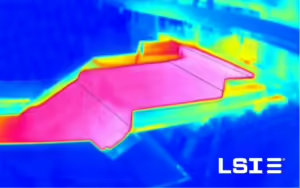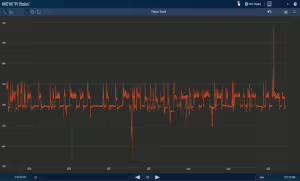The Situation
Our plant has a higher risk of fire due to the high-temperature grain cooking and toasting process. Our existing oven sensors do not provide early fire detection. Can LSI help us solve this issue and give us confidence that our process is robust and safe?
A large food manufacturer needed to implement detection systems that would minimize process upsets, such as incipient fires, and enhance the safety and integrity of its assets. Their existing oven’s internal detection system was unreliable and more suited for mature fire detection. Operators in the oven area observed the food flow along with other tasks, and if a problem, such as an incipient fire occurred, they manually shut down the system to investigate. This meant that food in the oven was all rejected, and there was downtime to clean the equipment and restart the flow of food. Consequently, the client wanted to replace the unreliable equipment with an integrated solution capable of variable spark/ember detection that could alert operators earlier to prevent waste, downtime, and potential damage to equipment. They also wanted a globally available solution to ensure equipment and support were available in all countries of operation.
Having worked extensively with the LSI team on previous projects, discussions began about an improved fire detection solution. The client had already evaluated infrared fire detection at sister plants internationally, but they wanted a full evaluation and pilot program to be completed in North America to avoid different technologies from one plant to the next. The client turned to LSI to thoroughly understand their process and needs, research and test various available technologies and install and commission a pilot project in one of their plants to pave the way for a global solution. The long-term goal was to propagate this solution across all their ovens in multiple plants.
The Solution
Discovery
 LSI traveled to two of the client’s international locations to evaluate the fire detection systems already in place on the ovens. The information gathered during these visits was analyzed and used to recommend a path forward for an active monitoring pilot system. During the discovery phase, LSI provided project management and engineering personnel who conducted equipment walkthroughs with line leadership, operations, and engineering teams. The LSI team then designed and implemented controls, spark/ember detection systems, and infrared cameras to collect trial data. They also performed data analysis, reviewed alternate technologies, and provided budget estimates to complete the pilot installation on various ovens across the client’s sites.
LSI traveled to two of the client’s international locations to evaluate the fire detection systems already in place on the ovens. The information gathered during these visits was analyzed and used to recommend a path forward for an active monitoring pilot system. During the discovery phase, LSI provided project management and engineering personnel who conducted equipment walkthroughs with line leadership, operations, and engineering teams. The LSI team then designed and implemented controls, spark/ember detection systems, and infrared cameras to collect trial data. They also performed data analysis, reviewed alternate technologies, and provided budget estimates to complete the pilot installation on various ovens across the client’s sites.
Pilot Spark Detection Installation
 For the pilot, LSI integrated spark/ember detection systems along with thermal imaging systems into Rockwell Automation’s GuardLogix 5580 to monitor and establish a baseline for early fire characteristics. To monitor the cooked product, thermal imaging camera systems, selected during the discovery phase, were installed and integrated with the oven’s existing Rockwell Automation ControlLogix PLCs and HMI. The existing PLC program was configured to collect data from the spark detection and thermal camera devices. LSI collaborated closely with the client team to add AVEVA PI tags for the collection of PLC spark detector and thermal camera data to the existing PI server platform. They also set up alarm thresholds to notify operations management of early fire potential via PI-generated emails and provided video footage of events for process study and training. This level of insight into the process was critical for the success of the pilot and the client’s follow-up plans to install LSI’s solution in its other plants.
For the pilot, LSI integrated spark/ember detection systems along with thermal imaging systems into Rockwell Automation’s GuardLogix 5580 to monitor and establish a baseline for early fire characteristics. To monitor the cooked product, thermal imaging camera systems, selected during the discovery phase, were installed and integrated with the oven’s existing Rockwell Automation ControlLogix PLCs and HMI. The existing PLC program was configured to collect data from the spark detection and thermal camera devices. LSI collaborated closely with the client team to add AVEVA PI tags for the collection of PLC spark detector and thermal camera data to the existing PI server platform. They also set up alarm thresholds to notify operations management of early fire potential via PI-generated emails and provided video footage of events for process study and training. This level of insight into the process was critical for the success of the pilot and the client’s follow-up plans to install LSI’s solution in its other plants.
LSI provided:
- Electrical design
- Control system integration
- Program Management support
- Control panel design and fabrication
- Technical oversight of the client’s subcontractors
The Results
Confidence and Assurance
- Oven systems now have the means to detect early fire potential capabilities to ensure appropriate action can be taken if there is a product fire. Being able to respond quickly significantly reduces waste and the risk of equipment damage.
Supportability
- The hardware used is readily available in all countries where the client operates. As the solution is rolled out globally, this will be important for long-term serviceability and support.
Rapid Communication and Response
- When spark/ember detection thresholds are met, the operators are immediately notified on HMI screens, and other notifications are sent to management via the PI system.
Change Management
- Notifications from the PI System are driving operations culture to discuss each instance and root cause review, further optimizing their processes.
What’s Next
The client is so pleased with the pilot program’s results that they’ve asked LSI to start planning for installation and integration in all of its plants—over 20 oven systems! In the meantime, LSI continues to help the client understand and gain confidence in the system. When the client is ready, LSI will support a corporate initiative to transition from operator-based oven control to automated controls and responses based on the system’s detection and data. LSI Listens.
